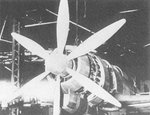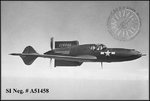It was never built past a wooden mockup stage. The type II prototype was built however it was never flown.
The Tachikawa Ki-94
The Tachikawa Ki-94 was to have a development life just the opposite of the Yokosuka R2Y Keiun in the aspect that the Ki-94 began as a radical and advanced thinking aircraft only to become, in the end, a much more conventional one.
In the summer of 1942, the aircraft firm of Tachikawa Hikoki K.K. and Koku Hombu ( Army Air Headquarters ) were in the midst of discussing and formulating the requirements and needs of a heavily armed, high-altitude interceptor. The Imperial Army desired to have a fighter, with a pressurized cabin for the pilot, which could attain a top speed of 497mph with a range of 1,864 miles. Knowing these guidelines were rather lofty, the Koku Hombu gave contracts to both Tachikawa, who would produce an aircraft to meet the guidelines, and to Nakajima who would produce an aircraft, also of a high-altitude type, but would not have to meet or exceed the range specifications placed upon the Tachikawa designers.
Tachikawa set about the process of creating an airframe and powerplant combination to meet the Koku Hombu's desires. In so doing, they laid out a very novel aircraft. The Ki-94, as it was now officially known, was a twin-boom, pusher-puller aircraft. Mitsubishi Ha-211 Ru 18-cylinder, air cooled radial engines were mounted in the front and rear of the fuselage, each driving a four-bladed air screw. The Ha-211 Ru could develop up to 2,200hp. a piece. The proposed armament was heavy, consisting of two 37mm Ho-203 cannon and two 30mm Ho-105 cannon, all firing forward. Tachikawa estimated the top speed of the Ki-94 to be upwards of 485mph at 32,810ft. As the design progressed, a full size wooden mock-up was built and was completed in late 1943.
The full-scale, wooden mock-up of the Ki-94-I, late 1943. From J.A.P.W.
When Tachikawa displayed the mock-up to the Army Air Headquarters, Tachikawa was in for a disappointment. The design was deemed to be too complex in the eyes of the Koku Hombu and they also felt the projected performance was rather optimistic. And thus, the Ki-94 project was scrapped. That the Hoku Hombu required of Tachikawa to create such a high-performance aircraft with high requirements and then, when a design proposed to meet them was of the unorthodox, to call it too complex and the figures inflated is rather difficult to understand but does go to illustrate how the thinkers of the old still retained sway...something which was to hamper the German aircraft designers as well. Only when the need was desperate did the more radical designs get the green light.
Given that their initial design was dismissed, Tachikawa was not to let Nakajima go unchallenged. They set about designing an aircraft using the guidelines given by the Koku Hombu to Nakajima, who was putting forth their Ki-87 project. The Tachikawa entry was a conventional airframe, powered by a Nakajima [Ha-44]12, 18-cylinder, turbosupercharged radial engine which developed 2,400hp. This engine drove a six-bladed propeller. The cabin was pressurized and the aircraft was given the armament array of two 30mm Ho-105 cannon and two 20mm Ho-5 cannon, all mounted in the wings. This design was approved by the Hoku Hombu, the aircraft designated the Ki-94-II ( the scrapped earlier Ki-94 design was named the Ki-94-I ). An order was placed for one static test airframe, three prototypes, and eighteen pre-production aircraft.
The first prototype of the Ki-94-II fitted with the stop-gap 4-bladed prop to speed completion. From J.A.P.W.
The first prototype of the Ki-94-II was to be ready on July 20, 1945 but delays caused this date to be pushed back two weeks. One of the delays was that the six-bladed air screw was not completed and in order to press ahead with the flight testing, a four-bladed propeller was fitted until the standard six-bladed prop could be delivered. Flight trials were slated to begin on August 18, 1945 with a second Ki-94-II under construction to be fitted with the six-bladed air screw. However, the end of the war stopped the construction of the second prototype and also it found the first prototype still being readied for its maiden flight, the Ki-94-II never taking to the air.
http://members.aol.com/pelzig/ki94.html










